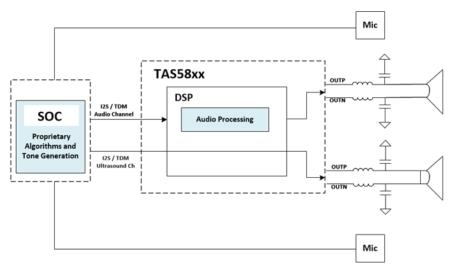SLAA539 September 2020 TAS5825M
2 Concept
Ultrasound applications include TVs, smart speakers and other IoT devices. The algorithm that can be developed utilizes existing hardware of the TAS5825M to generate ultrasonic tones at 96kHz sampling to make applications smarter and give users new, exciting, and valuable experiences. One of these experiences could be people detection; by detecting motion a smart speaker can double as a security system, pause a podcast when you leave the room, or change its volume based on a user’s distance. This can also be used for directivity where barriers or walls are detected and use multiple speakers to beam-form audio to create the best audio experience based on the surrounding. Another experience that utilizes ultrasound on the application is gesture detection where the user will use gestures to control the device (swipe to skip, or tap to pause). The forth option is for inter-speaker communication. Different devices can use ultrasonic tones to communicate basic information with each other, such as which AI speaker is closer to the source of a voice command.
Proprietary algorithms and tone generation can operate with existing speaker and mic architecture to incorporate all previously discussed features. This means the user’s design with the TAS5825M can remain the same and only incorporate the algorithm in software. TI Audio’s quality amplifiers provide high sampling rates and adequate frequency response to deliver the tones without adulteration. The TAS5825M supports late audio mixing to do processing on audio without affecting the ultrasound signal. Refer to the block diagram below for an example implementation.
 Figure 2-1 System Block Diagram
Figure 2-1 System Block DiagramThis plug in play option can also be achieved using one of TI’s third-party partners for the algorithm implementation. Since the solution is optimized with integrated tone generation into TAS5825, there’s far less demand for custom development on the host SOC. The amplifier’s DSP can generate tones at the high sampling rate necessary and reduce the processing burden on the host.